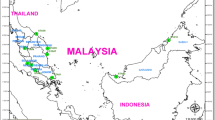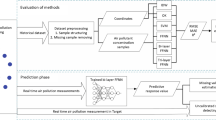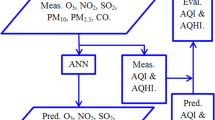Abstract
In the present work, two types of artificial neural network (NN) models using the multilayer perceptron (MLP) and the radial basis function (RBF) techniques, as well as a model based on principal component regression analysis (PCRA), are employed to forecast hourly PM10 concentrations in four urban areas (Larnaca, Limassol, Nicosia and Paphos) in Cyprus. The model development is based on a variety of meteorological and pollutant parameters corresponding to the 2-year period between July 2006 and June 2008, and the model evaluation is achieved through the use of a series of well-established evaluation instruments and methodologies. The evaluation reveals that the MLP NN models display the best forecasting performance with R 2 values ranging between 0.65 and 0.76, whereas the RBF NNs and the PCRA models reveal a rather weak performance with R 2 values between 0.37-0.43 and 0.33-0.38, respectively. The derived MLP models are also used to forecast Saharan dust episodes with remarkable success (probability of detection ranging between 0.68 and 0.71). On the whole, the analysis shows that the models introduced here could provide local authorities with reliable and precise predictions and alarms about air quality if used on an operational basis.








Similar content being viewed by others
References
Bari MdA, Baumbach G, Sarachage-Ruiz L, Kleanthous S (2009) Identification of PM10 sources in a Mediterranean island. Water Air Soil Pollut Focus 9(1–2):39–53
Boznar M, Lesjak M, Mlakar P (1993) A neural network-based method for short-term predictions of ambient SO2 concentrations in highly polluted industrial areas of complex terrain. Atmos Environ 27B(2):221–230
Chaloulakou A, Grivas G, Spyrellis N (2003a) Neural network and multiple regression models for PM10 prediction in Athens. A comparative assessment. J Air Waste Manage 53:1183–1190
Chaloulakou A, Kassomenos P, Spyrellis N, Demokritou P, Koutrakis P (2003b) Measurements of PM10 and PM2.5 particle concentrations in Athens, Greece. Atmos Environ 37:649–660
Corani G (2005) Air quality prediction in Milan: feed-forward neural networks, pruned neural networks and lazy learning. Ecol Model 185:513–529
Dennis JE, Schnabel RB (1983) Numerical Methods for Unconstrained Optimization and Nonlinear Equations. Prentice-Hall, Englewood Cliffs
Ding SQ, Xiang C (2004) From multilayer perceptrons to radial basis function networks: a comparative study. Proc 2004 IEEE Conf Cybern Intell Syst 1:69–74. doi:10.1109/ICCIS.2004.1460389
EC (1999) Directive 1999/30/EC of the European Parliament and of the Council of 22 April 1999 to limit values for SO2, NO2 and NOx, particulate matter and lead in ambient air. Official Journal of the European Communities No. L163, 41. Brussels
Gardner MW, Dorling SR (1999) Neural network modelling and prediction of hourly NOx and NO2 concentrations in urban air in London. Atmos Environ 33(5):709–719
Grivas G, Chaloulakou A (2006) Artificial neural network models for prediction of PM10 hourly concentrations in the Greater Area of Athens, Greece. Atmos Environ 40:1216–1229
Hooyberghs J, Mensinka C, Dumontb G, Fierensb F, Brasseurc O (2005) A neural network forecast for daily average PM10 concentrations in Belgium. Atmos Environ 39:3279–3289
Hrust L, Klaic ZB, Krizan J, Antonic O, Hercog P (2009) Neural network forecasting of air pollutants hourly concentrations using optimised temporal averages of meteorological variables and pollutant concentrations. Atmos Environ 43:5588–5596
Jayawardena AW, Fernando DAK, Zhou MC (1997) Comparison of multilayer perceptron and radial basis function networks as tools for flood forecasting. Proceedings of the Conference on Destructive water: water-caused natural disasters, their abatement and control. California, June 1996. IAHS Publ. no. 239: 173-181
Jolliffe IT (1986) Principal component analysis. Springer, New York
Kleanthous S, Bari MdA, Baumbach G, Sarachage-Ruiz L (2009) Influence of particulate matter on the air quality situation in a Mediterranean island. Atmos Environ 43:4745–4753
Kolehmainen M, Martikainen H, Hiltunen T, Ruuskanen J (2000) Forecasting air quality parameters using hybrid neural network modelling. Environ Monit Assess 65:277–286
Kukkonen J, Partanen L, Karppinen A, Ruuskanen J, Junninen H, Kolehmainen M, Niska H, Dorling S, Chatterton T, Foxall R, Cawley G (2003) Extensive evaluation of neural network models for the prediction of NO2 and PM10 concentrations, compared with a deterministic modelling system and measurements in central Helsinki. Atmos Environ 37:4539–4550
Lippmann RP (1987) An introduction to computing with neural nets. IEEE Acoust Speech Signal Process 4(2):4–22
Michaelides S, Nicolaides K, Karacostas T (2004) Statistical characteristics of the cold season depressions over the area of Cyprus. Meteorologicaky ˇcasopis 7:61–66
Middleton N, Yiallouros P, Kleanthous S, Kolokotroni O, Schwartz J, Dockery DW, Demokritou P, Koutrakis P (2008) A 10-year time-series analysis of respiratory and cardiovascular morbidity in Nicosia, Cyprus: the effect of short-term changes in air pollution and dust storms. Environmental Health 7: art no39
Nicolaides K, Mihaelides S, Karacostas T (2004) Spatial Distribution of some dynamic parameters during the evolution of selected depressions over the area of Cyprus. Int J Climatol 24:1829–1844
Nicolaides KA, Michalelides SC, Karacostas T (2006) Synoptic and dynamic characteristics of selected deep depressions over Cyprus. Adv Geosci 7:175–180
Papanastasiou DK, Melas D, Kioutsoukis I (2007) Development and assessment of neural network and multiple regression models in order to predict PM10 levels in a medium-sized Mediterranean city. Water Air Soil Poll 182:325–334
Paschalidou AK, Kassomenos PA, Bartzokas A (2009) A comparative study on various statistical techniques predicting ozone concentrations: implications to environmental management. Environ Monit Assess 148:277–289
Perez P, Reyes J (2002) Prediction of maximum of 24-h average of PM10 concentrations 30 h in advance in Santiago, Chile. Atmos Environ 36:4555–4561
Price C, Michaelides S, Pashiardis S, Alpert P (1999) Long term changes in diurnal temperature range in Cyprus. Atmos Res 51(2):85–98
Retalis A, Michaelides SC (2009) Synergetic use of TERRA/MODIS imagery and meteorological data for studying aerosol dust events in Cyprus. Int J Environ Pollut 36(1–3):139–150
Robbins H, Monro S (1951) A stochastic approximation method. Ann Math Stat 22:400–407
Roemer W, Hoek G, Brunekreef B, Clench-Aas J, Forsberg B, Pekkanen J, Schutz A (2000) PM10 elemental composition and acute respiratory health effects in European children (PEACE project). Eur Respir J 15:553–559
Schlink U, Dorling S, Pelikan E, Nunnari G, Cawley G, Junninen H, Greig A, Foxall R, Eben K, Chatterton T, Vondracek J, Richter M, Dostal M, Bertucco L, Kolehmainen M, Doyle M (2003) A rigorous inter-comparison of ground level ozone predictions. Atmos Environ 37:3237–3253
Wilks DS (1995) Statistical Methods in the Atmospheric Sciences. Academic, San Diego
Ziomas IC, Melas D, Zerefos CS, Bais AF, Paliatsos AG (1995) Forecasting peak pollutant levels from meteorological variables. Atmos Environ 29:3703–3711
Author information
Authors and Affiliations
Corresponding author
Additional information
Responsible editor: Euripides Stephanou
Rights and permissions
About this article
Cite this article
Paschalidou, A.K., Karakitsios, S., Kleanthous, S. et al. Forecasting hourly PM10 concentration in Cyprus through artificial neural networks and multiple regression models: implications to local environmental management. Environ Sci Pollut Res 18, 316–327 (2011). https://doi.org/10.1007/s11356-010-0375-2
Received:
Accepted:
Published:
Issue Date:
DOI: https://doi.org/10.1007/s11356-010-0375-2




